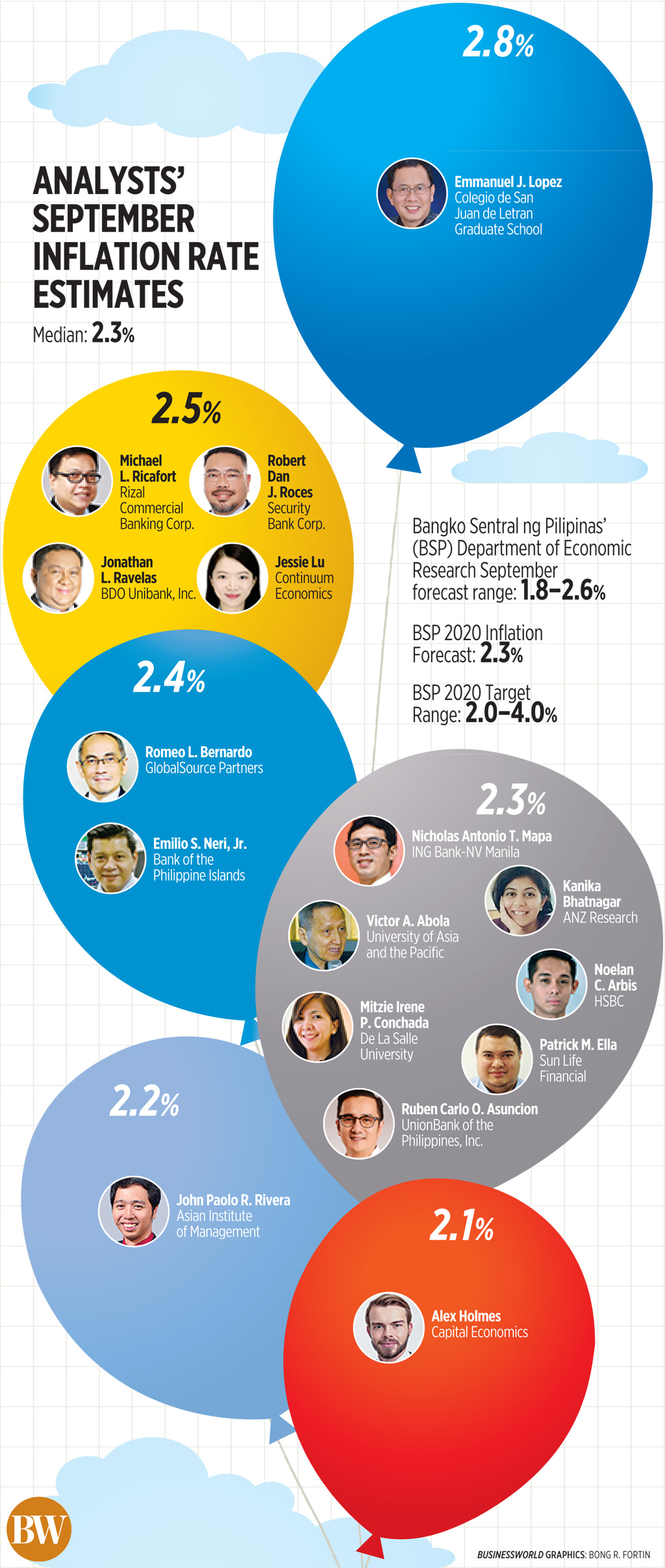
By Luz Wendy T. Noble, Reporter
HEADLINE INFLATION likely slowed further in September due to lower prices of some staple food and power rates, analysts said.
A BusinessWorld poll of 16 economists held last week yielded a median estimate of 2.3%, closer to the higher end of the 1.8% to 2.6% forecast range given by the Bangko Sentral ng Pilipinas (BSP) for September and well within the 2-4% target for the year.
If realized, the median estimate will be the second consecutive month of slower inflation, following the 2.4% pace in August. However, it is still much quicker than the 0.9% logged in September 2019 which was the slowest pace since the 0.7% seen in April 2016.
The Philippine Statistics Authority will report the September inflation data on Oct. 6.
Analysts said key factors that may have contributed to easing inflation are food and utility prices.
Jessie Lu, an economist from Continuum Economics, said downside pressure likely came from food and non-alcoholic beverages components.
“Some food items, however, have experienced a slight increase last month such as pork and chicken due to limited supply. Otherwise, prices of other commodities remain stable,” Mitzie Irene P. Conchada, an economist from the De La Salle University said.
In September, rice prices slipped, with average farmgate palay prices down by 2.2% week on week to P17.64 per kilogram in the first week of the month. Average wholesale price of regular-milled rice likewise dipped 0.7% to P34.99, while its retail price slipped 0.5% to P37.91.
Further downward pressures to inflation include lower utility and oil prices, according to ING Bank N.V. Manila Senior Economist Nicholas Antonio T. Mapa.
“Price gains will dip from the previous month despite base effects as the economy remains in recession while crude oil prices reflect a global downturn, helping cap utility prices and the recent pickup in transport costs,” Mr. Mapa said.
Manila Electric Co. (Meralco) power rates dropped by P0.0623 per kilowatt-hour (kWh) to P8.4288/kWh in September from the rates in August. September saw Meralco rates at its three-year low due to lower generation charge.
Meanwhile, some economists said inflation likely picked up last month as the economy continued to open up. Metro Manila and nearby provinces remained under a general community quarantine for the month of September.
“The semblance of normalcy displayed by the opening of some sectors of the economy including tourism and transportation has paved the way for the return to the usual transaction and economic activity,” Colegio de San Juan de Letran Graduate School Dean Emmanuel J. Lopez said.
While more modes of transportation are allowed to operate including buses and jeepneys, restrictions on capacity has made transport costs more expensive, said Rizal Commercial Banking Corp. Chief Economist Michael L. Ricafort.
“Capacity on mass transportation systems remains limited to prevent the COVID-19 from spreading further, thereby would still keep transport costs relatively higher,” Mr. Ricafort said.
The central bank has lowered its average inflation forecast for this year to 2.3% from 2.6%, citing a downward trend in oil prices.
The Monetary Board also maintained the overnight reverse repurchase, lending, and deposit rates at record lows of 2.25%, 2.75%, and 1.75% during its fifth policy review last Thursday. BSP Governor Benjamin E. Diokno said the current monetary policy settings “remain appropriate,” and noted some “encouraging signs” of recovery for the domestic economy.
The Monetary Board has slashed policy rates cumulatively by 175 basis points (bps) this year.
Analysts said the BSP may likely maintain benchmark rates at record lows, at least in the near-term given the inflation outlook.
“We expect the BSP to keep the key policy rate unchanged toward the yearend. Negative real interest rate likely constrains the central bank’s ability to lower rates further,” Ms. Lu said.
“Additional bouts of RRR (reserve requirement ratio) reduction will also likely be shelved for now given the liquidity situation,” Mr. Mapa said.
The RRR for big banks have been slashed by 200 bps to 12% while reserve requirements for thrift and rural lenders have been brought down by 100 bps to three percent and two percent, respectively. The Monetary Board is allowed to trim the RRR by up to 400 bps this year.
So far, the BSP’s moves have infused P1.5 trillion in liquidity into the financial system, Mr. Diokno said.
The last two policy review meetings are scheduled on Nov. 19 and Dec. 17.

